Nissan Pathfinder: Starting and driving - Blind Spot Warning (BSW)
Basic information Nissan Pathfinder SUV
WARNING Failure to follow the warnings and instructions for proper use of the BSW system could result in serious injury or death.
- The BSW system is not a replacement for proper driving procedures and is not designed to prevent contact with vehicles or objects. When changing lanes, always use the side and rear mirrors and turn and look in the direction your vehicle will move to ensure it is safe to change lanes. Never rely solely on the BSW system.
- Do not use the BSW system when towing a trailer. The system may not function properly.
The BSW system helps alert the driver of other vehicles in adjacent lanes when changing lanes.
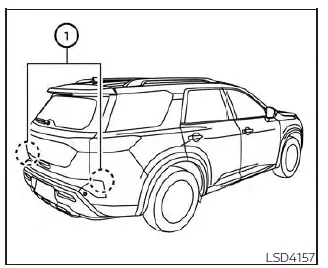
The BSW system uses radar sensors 1 installed near the rear bumper to detect other vehicles in an adjacent lane.
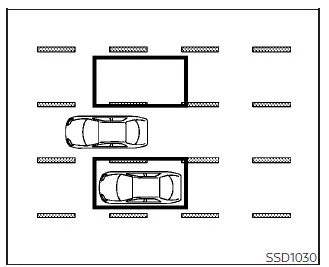
Detection zone
The radar sensors can detect vehicles on either side of your vehicle within the detection zone shown as illustrated. This detection zone starts from the outside mirror of your vehicle and extends approximately 10 ft (3.0 m) behind the rear bumper, and approximately 10 ft (3.0 m) sideways.
BSW system operation
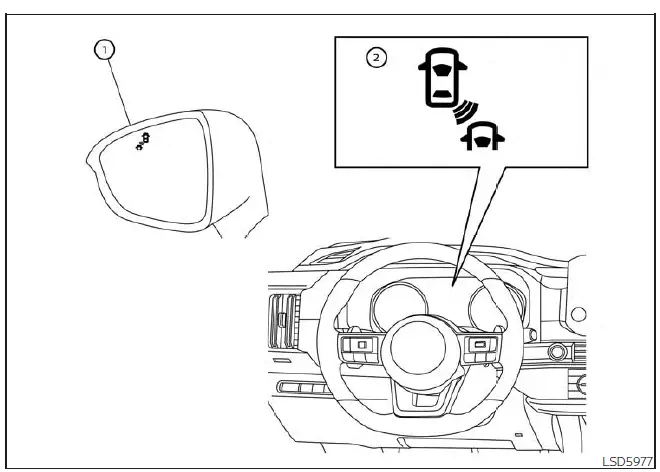
For vehicles with the 7 inch (18 cm) display
- Side BSW/RCTA Indicator Light
- BSW Indicator
The BSW system operates above approximately 20 mph (32km/h).
If the radar sensors detect a vehicle in the detection zone, the side BSW/RCTA indicator light (1) illuminates. If the turn signal is then activated, the system chimes (twice) and the side BSW/RCTA indicator light and the BSW indicator flash. The side BSW/RCTA indicator light and the BSW indicator continue to flash until the detected vehicles leaves the detection zone.
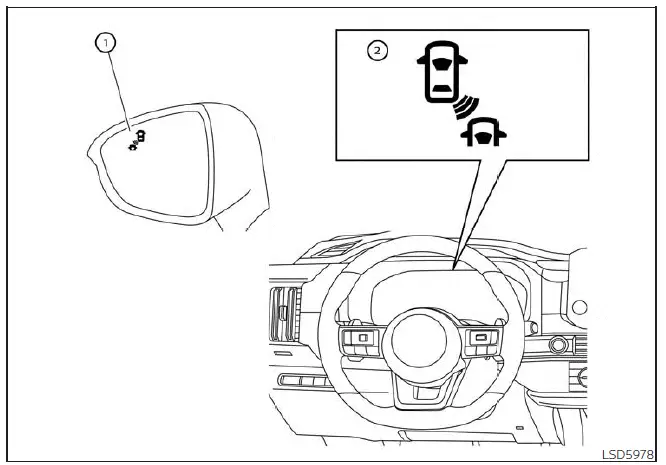
For vehicles with the 12.3 inch (31.2 cm) display
The side BSW/RCTA indicator light illuminates for a few seconds when the ignition switch is placed in the ON position.
The brightness of the side BSW/RCTA indicator light is adjusted automatically depending on the brightness of the ambient light.
How to enable/disable the BSW system
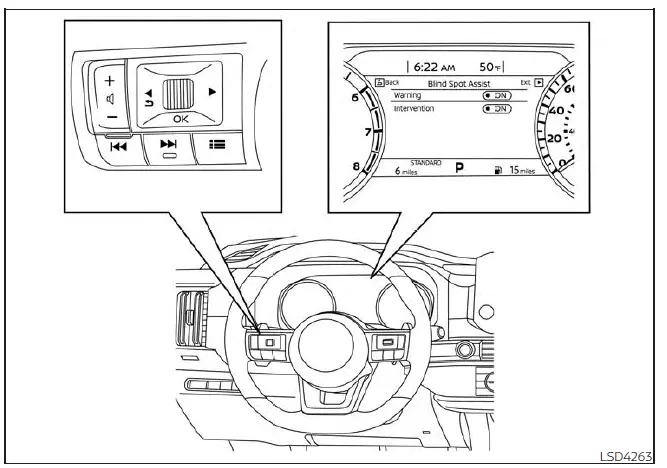
For vehicles with the 7 inch (18 cm) display
Perform the following steps to enable or disable the BSW system.
1. Press the
 button until
"Settings" displays
in the vehicle information display.
button until
"Settings" displays
in the vehicle information display.
Use the scroll dial to select "Driver Assistance." Then press the OK button.
2. Select "Blind Spot Assist" and press the OK button.
3. Select "Warning" and press the OK button to turn the system on or off.
NOTE:
- When enabling/disabling the system, the system will retain current settings even if the engine is restarted.

For vehicles with the 12.3 inch (31.2 cm) display
BSW system limitations
WARNING Listed below are the system limitations for the BSW system. Failure to operate the vehicle in accordance with these system limitations could result in serious injury or death.
- The BSW system cannot detect all vehicles under all conditions.
- The radar sensors may not be able to
detect and activate BSW when certain
objects are present such as:
- Pedestrian, bicycles, animals.
- Vehicles such as motorcycles, low height vehicles, or high ground clearance vehicles.
- Oncoming vehicles.
- Vehicles remaining in the detection zone when you accelerate from a stop.
- A vehicle merging into an adjacent lane at a speed approximately the same as your vehicle.
- A vehicle approaching rapidly from behind.
- A vehicle which your vehicle overtakes rapidly.
- A vehicle that passes through the detection zone quickly.
- When overtaking several vehicles in a row, the vehicles after the first vehicle may not be detected if they are traveling close together.
- The radar sensors' detection zone is designed based on a standard lane width. When driving in a wider lane, the radar sensors may not detect vehicles in an adjacent lane. When driving in a narrow lane, the radar sensors may detect vehicles driving two lanes away.
- The radar sensors are designed to ignore most stationary objects; however, objects such as guardrails, walls, foliage and parked vehicles may occasionally be detected. This is a normal operation condition.
- The following conditions may reduce
the ability of the radar to detect other
vehicles:
- Severe weather
- Road spray
- Ice/frost/snow/dirt build-up on the vehicle
BSW driving situations Nissan Pathfinder 5th Gen
Basic information
Indicator on

Indicator off

Indicator flashing

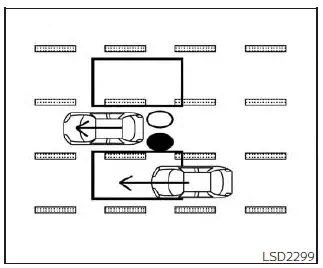
Illustration 1 - Approaching from behind
Another vehicle approaching from behind
Illustration 1: The side BSW/RCTA indicator light illuminates if a vehicle enters the detection zone from behind in an adjacent lane.
NOTE:
- The radar sensors may not detect vehicles which are approaching rapidly from behind.
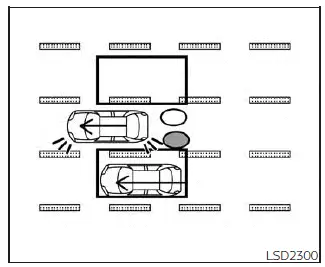
Illustration 2 - Approaching from
behind
Illustration 2: If the driver activates the turn signal when another vehicle is in the detection zone, then the system chimes (twice) and the side BSW/RCTA indicator light and the BSW indicator flash.
NOTE:
- The radar sensors may not detect vehicles which are approaching rapidly from behind.
- If the driver activates the turn signal before a vehicle enters the detection zone, the side BSW/RCTA indicator light and the BSW indicator will flash but no chime will sound when the other vehicle is detected.
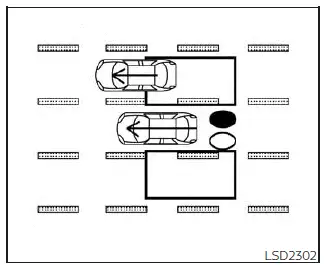
Illustration 3 - Overtaking another
vehicle
Overtaking another vehicle
Illustration 3: The side BSW/RCTA indicator light illuminates if you overtake a vehicle and that vehicle stays in the detection zone for approximately 2 seconds.
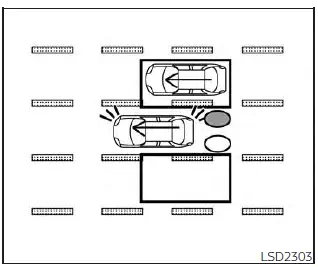
Illustration 4 - Overtaking another
vehicle
Illustration 4: If the driver activates the turn signal while another vehicle is in the detection zone, then the system chimes (twice) and the side BSW/RCTA indicator light and the BSW indicator flash.
NOTE:
- When overtaking several vehicles in a row, the vehicles after the first vehicle may not be detected if they are traveling close together.
- The radar sensors may not detect slower moving vehicles if they are passed quickly.
- If the driver activates the turn signal before a vehicle enters the detection zone, the side BSW/RCTA indicator light and the BSW indicator will flash but no chime will sound when the other vehicle is detected.
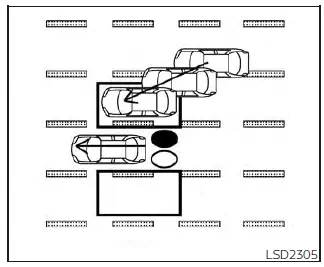
Illustration 5 - Entering from the side
Entering from the side
Illustration 5: The side BSW/RCTA indicator light illuminates if a vehicle enters the detection zone from either side.
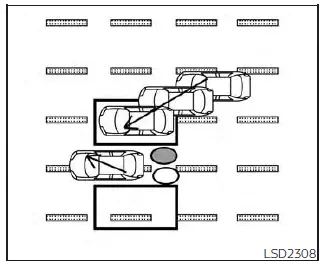
Illustration 6 - Entering from the side
Illustration 6: If the driver activates the turn signal while another vehicle is in the detection zone, then the system chimes (twice) and the side BSW/RCTA indicator light and the BSW indicator flash.
NOTE:
- If the driver activates the turn signal before a vehicle enters the detection zone, the side BSW/RCTA indicator light and the BSW indicator will flash but no chime will sound when the other vehicle is detected.
- The radar sensors may not detect a vehicle which is traveling at about the same speed as your vehicle when it enters the detection zone.
System temporarily unavailable Nissan Pathfinder 5th Gen
Basic information
When radar blockage is detected, the system will be deactivated automatically.
The "Unavailable: Side Radar Obstruction" warning message will appear in the vehicle information display.
The system is not available until the conditions no longer exist.
The radar sensors may be blocked by temporary ambient conditions such as splashing water, mist or fog. The blocked condition may also be caused by objects such as ice, frost or dirt obstructing the radar sensors.
NOTE: If the BSW system stops working, the RCTA and I-BSI systems (if so equipped) will also stop working.
Action to take:
When the above conditions no longer exist, the system will resume automatically.
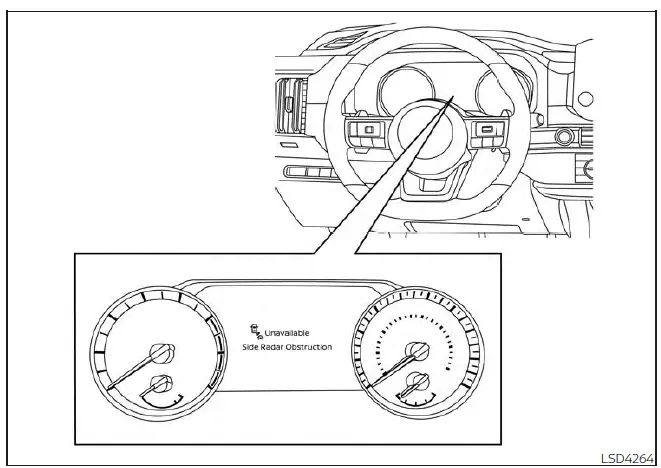
For vehicles with the 7 inch (18 cm) display
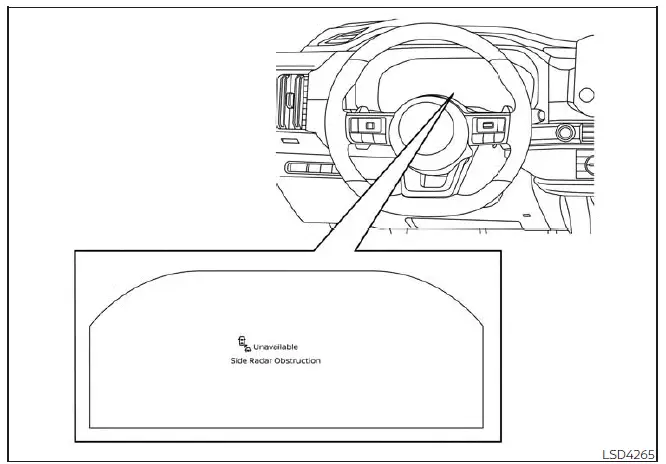
For vehicles with the 12.3 inch (31.2 cm) display
Malfunction
If the BSW system malfunctions, it will turn off automatically. The system malfunction warning message will appear in the vehicle information display.
NOTE: If the BSW system stops working, the RCTA and I-BSI systems (if so equipped) will also stop working.
Action to take:
Stop the vehicle in a safe location, place the vehicle in the P (Park) position, turn the engine off and restart the engine. If the message continues to appear, have the system checked. It is recommended that you visit a NISSAN dealer for this service.
System maintenance
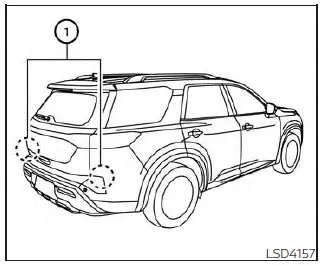
Basic information
The two radar sensors 1 for the BSW and RCTA systems are located near the rear bumper. Always keep the area near the radar sensors clean.
The radar sensors may be blocked by temporary ambient conditions such as splashing water, mist or fog.
The blocked condition may also be caused by objects such as ice, frost or dirt obstructing the radar sensors.
Check for and remove objects obstructing the area around the radar sensors.
Do not attach stickers (including transparent material), install accessories or apply additional paint near the radar sensors.
Do not strike or damage the area around the radar sensors. It is recommended that you consult a NISSAN dealer if the area around the radar sensors is damaged due to a collision.
Radio frequency statement
For USA
CAUTION TO USERS
Changes or modifications not expressly approved by the party responsible for compliance could void the user's authority to operate the equipment.
This device complies with Part 15 of the FCC Rules and with the RSS of the Industry Canada. Operation is subject to the following two conditions:
1. This device may not cause harmful interference,
and
2. this device must accept any interference received, including interference that may cause undesired operation.
In order to comply with FCC RF Exposure requirements, this device must be installed to provide at least 20 cm separation from the human body at all times.
For Canada
This device complies with Industry Canada licence-exempt RSS standard(s).
Operation is subject to the following two conditions: (1) this device may not cause interference, and (2) this device must accept any interference, including interference that may cause undesired operation of the device.
Afin de se conformer aux exigences d'exposition RF MIC / FCC / ISED, cet appareil doit etre installe pour foutnir au moins 20 cm de separation du corps humain en tout temps.

Nissan Pathfinder (R53) 2022-2025 Owner's Manual
Blind Spot Warning (BSW)
Contact Us
Nissan Pathfinder Info Center
Email: info@nipathfinder.com
Phone: +1 (800) 123-4567
Address: 123 Pathfinder Blvd, Nashville, TN 37214, USA
Working Hours: Mon–Fri, 9:00 AM – 5:00 PM (EST)
